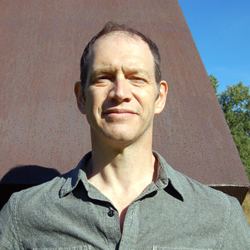Years active 1979–present Website www.markgustavson.com | Name Mark Gustavson Role Composer | |
 | ||
Education Northern Illinois University Residence Mastic Beach, New York, United States | ||
Mark gustavson jag for chamber ensemble 1991
Mark Gustavson (born September 19, 1959 in Brooklyn, New York) is an American composer of contemporary classical music.
Contents
- Mark gustavson jag for chamber ensemble 1991
- Trickster scrolling score by Mark Gustavson
- Biography
- Music
- Select list of compositions
- Discography
- References
Trickster (scrolling score) by Mark Gustavson
Biography
Gustavson lives on eastern Long Island, and teaches at various universities in the New York City area, including Adelphi University and Nassau Community College. He graduated from the University of Illinois in 1981 and received a D.M.A. from Columbia University in 1990. Gustavson also studied at the Sweelinck Conservatory with Ton De Leeuw on a Fulbright Fellowship in 1985-86 and was a composition fellow at Tanglewood in 1979. His primary composition teachers were Chinary Ung, Ben Johnston and Fred Lerdahl.
Music
Western classical music, Folk music from around the world, and Jazz blended with Eastern and Western philosophy have all influenced Gustavson's style. He mostly favors notated music that often sounds improvised. Form is often based on different approaches to variations influenced by naturally occurring cycles . Rhythm can at times be very complex or deceptively simple; for example, the third movement of Quintet for clarinet, two violins, viola, and cello is a four-voice canon of continuous eighth notes that create a background for the solo clarinet. Because of the unpredictable entrances of each voice an improvisatory quality is suggested. In A Fool's Journey, it is the complex textures that create the illusion of improvisation. The complex layering of lines or polyphony in this example from "A Fool's Journey" purposely avoids the coming together of the independent voices. The Prelude to "Lament" for piano solo demonstrates another way to create the sense of improvisation by using a basso ostinato in the left hand and a rhythmically free right hand. One more example from a recent work "Turning" for bass clarinet, percussion, piano and double bass explores many ways of creating the illusion of improvisation. This example demonstrates metrical independence of the four instruments, and at times, simultaneously in four different meters.
His music has been recognized with various awards and prizes, including the American Academy of Arts and Letters Walter Hinrichsen Award (1987), the Joseph H. Bearns Prize, the BMI Student Composer Award (1979, 1982, 1983), and the ASCAP Foundation Morton Gould Young Composer Award.
In the first decade of the 21st century, Gustavson's attention turned to texts and vocal music. Two works of note are The Fisherman Songs for bass/baritone and piano and Lament, a monodrama for bass/baritone, bass clarinet, percussion, piano, female chorus, and double bass, using a poem of the same title by Dylan Thomas.
Prelude from "Lament" for bass clarinet, percussion, piano and double bass is performed by the pianist Jacob Rhodebeck and "Turning" was performed by the Stony Brook Contemporary Chamber Players. A recording with Quintet performed by Contempo and Dissolving Images for solo piano performed by Lisa Moore are available on Albany Records,. and "Dissolving Images" and "Quintet" are published by Edition Peters.
Select list of compositions
Orchestra
Band & Wind ensemble
Chamber
Vocal
Solo instrumental
Electroacoustic
